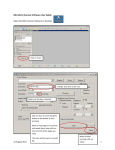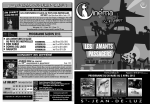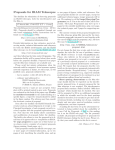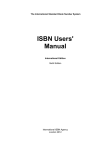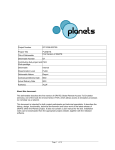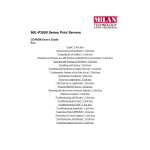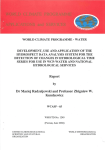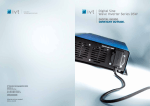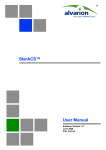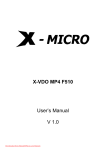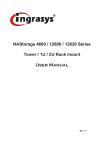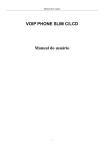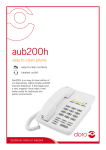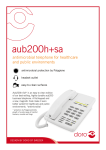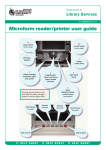Download ISO/TC 46/SC 9 /WG 4 N 23 Preface 1. Background 2. Advantages
Transcript
ISO/TC 46/SC 9 /WG 4 N 23 Draft revisions to ISBN User Manual by the WG4 ad hoc group on scope and principles Date: 2002-09-19 Preface Not part of group tasks 1. Background Not part of group tasks 2. Advantages of the ISBN Not part of group tasks 3. The function and scope of ISBN Preamble The International Standard Book Number is known throughout the world as a short, clear and potentially machine-readable identification number. The ISBN identifies a publication unmistakably and should accompany it from its earliest production stages onwards. It is an essential instrument in modern production, distribution, sales tracking and storage systems in the booktrade (alternative wording: information industry) as well as in library information management. In cases where a product is covered by other specific numbering systems, (such as ISSN for serial publications and ISMN for sheet music), (alternative wording 1: such as ISSN for continuing resources and other serial publications and ISMN for sheet music) (alternative wording 2: such as ISSN for continuous publications and other serial publications and ISMN for sheet music) then these should be used. Scope This International Standard is applicable to published books (alternative wording: published textbased books) (or their individual sections or chapters where these are made separately available) and other monographic publications (alternati ve wording 1: other monographic products) (alternative wording 2: some types of non-book products) that are available to the general public. The term ”book” is used in this manual in the sense of “monographic publication”. ” (Alternative wording 1: The term “book” should be understood as synonymous with “monographic publication”.) (Alternative wording 2: delete this sentence entirely). A monograph is a publication containing text, or text and illustration, conceived as a whole in one part or within a predetermined finite number of parts by publisher/author(s) and offered for general distribution in any print or electronic media or combination of such. For the purposes of the ISBN system monographic publications that may be numbered include: A. Printed books and pamphlets including Braille and maps2 and those produced using print on demand (alternative wording: digital print) technology B. • • • • Non-printed books Educational/instructional films, videos and transparencies Audio books on cassettes or CDs (talking books) Microform publications Educational or instructional microcomputer software __________________________________________________________________________ 2 It has been agreed not to draft international rules for assigning ISBNs to maps because there is evidence that the system works quite well on a national basis. For cartographic products (e.g. atlases) sold in the book market, the ISBN rules shall apply. For example, as with books, minor alterations do not constitute a new edition. ISO/TC 46/SC 9/WG 4 N 23 Draft revisions to ISBN User Manual by the WG4 ad hoc group on scope and principles Date: 2002-09-19 • Electronic publications - Machine-readable tapes - Diskettes - CD-ROMs - Internet publications C. Mixed media publications (where the principal constituent is text-based) Except: • Ephemeral printed materials such as diaries, calendars (notebooks) 3, advertising matter and the like • Art prints and art folders without title page and text • Publications qualified in terms of content but available only on a li mited basis, such as customised print on demand publications, private or society publications where these are only available to members • Sound recordings (see chapter 12.3) • Sheet music (see chapter 12.2) Alternative extra wording: Some further examples of the types of material to which an ISBN shall not be issued are: - serial publications including newspapers, newsletters, magazines, journals, integrating resources) (see chapter 12.1)(alternative wording 1: - continuing resources (including serial publications, newspapers, newsletters, magazines, journals, integrating resources) (see chapter 12.1) (alternative wording 2: - continuous publications (including serial publications, newspapers, newsletters, magazines, journals, integrating resources) (see chapter 12.1) - abstract works - websites - bulletin boards - emails and other electronic correspondence - search engines - games - personal documents (such as electronic curriculum vitae and personal profiles) 4. Structure of ISBN Not part of group tasks 5. Application of ISBN 5.1 General A separate ISBN shall be assigned to every title, or edition of a title by each publisher. Different versions of a publication (e.g. Braille, audio book, online electronic publication) require new and separate ISBNs. Online electronic publications in different formats should also be regarded as different editions. The same title being published in both a series and individually, is regarded as two different editions and shall be assigned separate ISBNs. A revised edition shall require a new ISBN. A cover or price change of a monographic publication does not require a new or separate ISBN. 5.2 Facsimile reprints __________________________________________________________________________ 3 Wall calendars and calendars in book form with plates and text are assigned ISBN in a number of countries as they are considered genuine publications. 2 ISO/TC 46/SC 9/WG 4 N 23 Draft revisions to ISBN User Manual by the WG4 ad hoc group on scope and principles Date: 2002-09-19 A separate ISBN shall be assigned to a facsimile reprint when it is produced by another publisher. 5.3 Products in different formats (Alternative wording: Books in different formats) A new and separate ISBN shall be assigned to each different format in which a particular title is published (e.g. cloth, paperback, Braille, microform, software, video or electronic versions and formats of the same work shall each be assigned a separate ISBN). 5.4 Loose-leaf publications An ISBN should be assigned to a finite loose-leaf publication, that is, a loose-leaf publication not intended to be continuously updated. 5.5 Multi-volume publications Publications may comprise more than one volume and in these cases an ISBN must be assigned to cover the entire set. Where individual volumes of the set are sold separately, each volume must be assigned a unique ISBN to identify it. The verso of the title leaf in each case should clearly display the ISBN for the set as a whole as well as the ISBN for that particular volume. If the multiple volume publication will only be sold as a set, the assignment of an individual ISBN to each separate volume is still recommended. Doing so will facilitate various stages of transaction processing including the handling of shipments when not all volumes are simultaneously published or distributed and the supply of replacements in the case of damaged copies. 5.6 Backlist Section to be drafted 5.7 Collaborative publications Section to be drafted 5.8 Books sold or distributed by agents Section to be drafted 5.9 Acquisition of one publisher by another Section to be drafted 5.10 Acquisition of complete stock of a publisher Section to be drafted 5.11 Publishers with more than one place of publication Section to be drafted 5.12 Register of ISBN Section to be drafted 5.13 ISBN can never be re-used Section to be drafted 6. ISBN for electronic publications and microcomputer software 6.1 The ISBN also applies to certain types of electronic publications: • Electronic publications consisting of one or more computer-readable files whether available to the general public online or in physical form (such as CD-ROMs, diskettes or electronic books) may be assigned ISBN if they consist primarily of text, are complete and finalised and are not intended to be issued more frequently than annually. 3 ISO/TC 46/SC 9/WG 4 N 23 Draft revisions to ISBN User Manual by the WG4 ad hoc group on scope and principles Date: 2002-09-19 (Alternative wording: Electronic publications consisting of one or more computer-readable files whether available to the general public online or in physical form (such as CD-ROMs, diskettes or electronic books) may be assigned ISBN if they consist primarily of text, are complete and finalised and are not intended to be continued indefinitely.) • Such publications may also include pictures and sounds but linked material (e.g. hypertext) would only be considered covered by the same ISBN if the related material were actually part of the publication. The following types of electronic publications should (alternative wording: shall) not be assigned ISBN: • • • • • • • • • Publications that are subject to frequent update and where access is possible to these changes almost immediately, such as online databases Websites Promotional or advertising materials Bulletin boards Emails and other electronic correspondence Search engines Games Personal documents (such as electronic curriculum vitae and personal profiles) Schedulers/diaries 6.2 ISBN for eligible software products An ISBN may be used to identify a specific software product that is intended for educational and/or instructional purposes, such as a computer based training product.(Alternative wording: An ISBN may be used to identify a specific software product that is intended for educational and/or instructional purposes, such as a computer based training product, provided that it is not customisable or requires data in order to function.) ISBNs may not be assigned to software products that are intended for entertainment only, such as computer games. (Alternative wording1: All other software products (e.g. computer games) shall not be assigned an ISBN). (Alternate wording 2: All other software monographic publications (e.g. computer games) shall not be assigned an ISBN). 6.3 Principles for assignment of ISBN to electronic publications and eligible software products • Where a specific, qualifying publication or product is available using different operating systems and/or command languages, each separate format should be assigned a unique ISBN. Neither operating systems nor reading devices themselves should, however, be assigned ISBN. • When a publication or product is updated, revised or amended and the changes are sufficiently substantial for the publication to be called a new edition, a new ISBN must be assigned. • A relaunch of an existing publication or product, even in new packaging, where there is no significant difference in the performance of the new from the old product, does not merit a new ISBN. The existing ISBN shall continue to be used. 4 ISO/TC 46/SC 9/WG 4 N 23 Draft revisions to ISBN User Manual by the WG4 ad hoc group on scope and principles Date: 2002-09-19 • A single ISBN may cover two or more items in a package consisting of the software product and its accompanying user and technical manuals if the manuals are necessary in order to operate the software and are useful only as an adjunct to the software. • If the package consists of two or more items which will be made available separately and can be used independently, then the entire package should have a distinct ISBN as must each separate component. • An ISBN should be assigned to a software product independently of its physical form (e.g. such as software that must be downloaded to the customer from a remote database). • As well as identifying the product (alternative wording: software product) itself, an ISBN identifies the publisher or producer (alternative wording: producer or manufacturer); it should not be used to identify a distributor or wholesaler of the product. 7. ISBN for print on demand publications The manufacturing process by which a publication is produced using digital print technology. An "on demand" publication is considered a book that is manufactured or printed as a single copy at the time a customer wants to buy it. Print on demand should not be confused with short-run printing (with the latter, companies print small runs of books e.g. 50-100, store them, and then ship them). Print on demand allows publishers to test demand for a new title, or determine whether an out-ofprint title still has shelf life. A copy of some edition of a title reproduced on demand via rudimentary photocopy, the text of which is exactly the same as the edition copied, while physical aspects of the book are different, shall receive a new ISBN. A copy of some edition of a title, reproduced on demand via the new reproduction technology, by a publisher that has bought on demand rights to another publisher's title shall receive a new ISBN. A copy produced via the new technology by an organization other than the publisher on behalf of that publisher (i.e. no rights have changed hands), where the on demand edition takes the place in the market of the publisher's printed edition in a different format shall receive a new ISBN. A "customised" version of a print on demand book, where the customer, not the publisher, dictates the content of the book, and for which it has a limited availability, shall not be assigned an ISBN. 8. Location and display of the ISBN on publications 8.1. General The ISBN must appear on the item itself. This is essential for the efficient running of the system. The ISBN must appear: • on the verso of the title page (copyright page) • on the foot of the title page, if there is no space elsewhere (alternative wording: on the foot of the title page, if there is no space on the title verso) • on the lower section of the outside back cover 5 ISO/TC 46/SC 9/WG 4 N 23 Draft revisions to ISBN User Manual by the WG4 ad hoc group on scope and principles Date: 2002-09-19 • • • • on the foot of the back of the jacket, or any other protective case, or wrapper on the base of the spine (only if the product is a paperback book) (alternative wording – delete this sentence) on the title display, or the first display (compact discs, online publications) or on the screen that displays the title or its equivalent (e.g. the initial screen displayed when the content is first accessed and/or on the screen that carries the copyright notice). on the credit titles (film, video) (Alternative wording – delete this sentence) If the publication is issued in a container that is an integral part of the publication (e.g. a compact disc, cassette or diskette), the ISBN shall be displayed on any labels permanently affixed to that container. If it is not possible to display the ISBN on the container or its label, then the ISBN shall be displayed at the bottom of the back of any packaging for that container (e.g. the box, sleeve or frame). The different formats of an electronic publication should be given an individual ISBN. All the ISBNs should be listed one below the other on all versions and the abbreviated format should be mentioned in brackets at the end of its ISBN. Examples: ISBN 951-45-9694-3 ISBN 951-45-9695-1 ISBN 951-45-9696-X ISBN 951-45-9999-9 (Print) [Alternative wording: (Paperback)] (PDF) (HTML) (OEB) Alternative wording: The different formats of an electronic monographic publication should be given an individual ISBN. It is recommended that ISBNs for different formats of a publication also be listed one below the other on all versions and the abbreviated format should be mentioned in parentheses at the end of its ISBN Examples: ISBN 951-45-9694-3 ISBN 951-45-9695-1 ISBN 951-45-9696-X ISBN 951-45-9999-9 (Print) [Alternative wording: (Paperback)] (PDF) (HTML) (OEB) See also Appendix 4.1. The ISBN shall also appear on any accompanying material issued in conjunction with the publication. The ISBN should always be printed in type large enough to be easily legible (i.e. 9 point or larger). 8.2 ISBN in bar-coded form Not part of group tasks 8.3 Five-digit add-on code Not part of group tasks 8.4 Providing the ISBN Bookland EAN bar code – instructions for film master suppliers Not part of group tasks 8.5 Algorithm for generating the Bookland EAN from the ISBN Not part of group tasks 8.6 Algorithm for reconstructing the ISBN from the EAN 6 ISO/TC 46/SC 9/WG 4 N 23 Draft revisions to ISBN User Manual by the WG4 ad hoc group on scope and principles Date: 2002-09-19 Not part of group tasks 9. Administration of the ISBN system Not part of group tasks 10. Non-participating publishers Section to be drafted 11. Practical uses of ISBN Not part of group tasks 12. ISBN and EAN Not part of group tasks 13. ISBN and other identifiers 13.1 – 13.6 – not part of group tasks 13.7 DOI The Digital Object Identifier (DOI) is a system for persistent identification and interoperable exchange of intellectual property on digital networks. The International DOI Foundation, a nonprofit organisation, manages development, policy, and licensing of the DOI system to registration agencies. For further information, refer to http://www.doi.org. DOIs may be used to identify any intellectual property entity, including those already identified by systems such as ISBN, and can be used compatibly with ISBN. Structure of a DOI The DOI has two components, the prefix and the suffix, which together form the DOI. There is no limitation on the length of a DOI. A DOI may be assigned to any item of intellectual property, which must be precisely defined by means of structured metadata. The DOI itself remains persistent through ownership changes, and unaltered once assigned. A prefix is assigned to an organisation that wishes to register DOIs; any organisation may choose to have multiple prefixes designing imprints, or journals, etc. Following the prefix (separated by a forward slash) is a suffix (unique to a given prefix) to identify the entity. The combination of a prefix for the Registrant and unique suffix provided by the Registrant avoids any necessity for the centralized allocation of DOI numbers. An existing standard identification system number such as ISBN may be integrated into a DOI, by using this as the suffix. In this case, it is of course recommended that precisely the same entity be identified by the two systems. In such case, the DOI assumes the following form: 10.8888 / ISBN 88-85025-23-4 where “10” is the number assigned to DOI within the Handle resolution system, “8888” is the registrant number, and the string after the slash is the suffix incorporating the ISBN. 7 ISO/TC 46/SC 9/WG 4 N 23 Draft revisions to ISBN User Manual by the WG4 ad hoc group on scope and principles Date: 2002-09-19 Features of DOI The DOI system uses a Resolution System that ensures persistence by resolving the DOI to a current associated value such as a URL; users of DOIs need not be aware of changes to URLs in order to use the system. The DOI system is a URI and URN implementation. The Resolution System is the Handle System, an open standard scalable architecture, provided by CNRI. Resolution may be to multiple pieces of data and can be – not mandatory – to the identified entity. Resolution should not be confused with identification: DOI can resolve to information other than the identified entity, and entities not reachable on the network can be identified. The DOI system uses a Metadata system based on the Indecs (interoperability of data in ecommerce systems) activity, consistent with metadata systems such as ONIX and MPEg-21 RDD. The DOI metadata enables mappings between application areas to be made consistently. DOI Policy and governance provide rules and mechanisms for implementation, which achieve practical implementation in a similar way to ISBN, EAN/UCC codes, Visa numbers etc., by means of a number of Registration Agencies that operate under the same rules as an operational federation. Added value services may be built using DOI features. These include the use of multiple resolution (associating DOIs with several items of data); associating related pieces of intellectual property (versions, derivations, etc); use with other tools (e.g. OpenURL for contextual local use). 13.8 Internet identifiers: URN and URI URN (Uniform Resource Name) and URI (Uniform Resource Identifier) are schemes for persistent identifiers of resources in the internet. By design, ISBNs and other identifiers are compatible with URN and URI schemes. URIs and URNs should therefore be considered as a “framework” for enabling identifiers to work in an internet environment, rather than as a competing system of identification to existing schemes such as ISO identifiers. Definitions of URN and URI concept are spread across a number of documents; the specifications are also continuing to evolve. The document Naming and Addressing: URIs, URLs, etc. (http://www.w3.org/Addressing/#19991) provides an overview of W3C material. The URN concept was originally driven by the IETF; the URI concept is championed by the W3C. For further information, refer to the documents linked from the W3C site noted above. Existing identifiers such as ISBN, ISMN, DOI, etc may be registered as URI and URN schemes. This would enable implementations to make use of the technical specification. URI, Uniform Resource Identifier (but, in some publications from W3C, also “Universal Resource Identifier”), is defined as “the generic set of all names/addresses that are short strings that refer to resources”. A URI may be a pure name or de-referenced by any service; in the latter case, the namespace provides its own mechanism (“bootstrapping”). On its own, any URI specification is just a specification: it requires code distribution for any implementation. URIs are not intended to rely on any additional network services. A software client either knows what to do with, e.g., ftp, or it does not: this is the key difference with the URN specification. URN, Uniform Resource Name is defined according to W3C in two ways: (1) as “an URI that has an institutional commitment to persistence, availability, etc.”; (2) as “a particular scheme, urn: specified by RFC2141 and related documents, intended to serve as persistent, locationindependent, resource identifiers.” URN architecture (RFC 2141) assumes an additional network service that would allow a client to deal with a previously unknown URN type, e.g., urn:isbn. Specifically, a DNS-based middle layer (RDS) is used to find the specific service appropriate to the given URN scheme. URN resolutions are then delegated to that scheme-specific resolution 8 ISO/TC 46/SC 9/WG 4 N 23 Draft revisions to ISBN User Manual by the WG4 ad hoc group on scope and principles Date: 2002-09-19 service. The original RDS mechanism proposed was NAPTR (Name Authority Pointer); more recently a variant of this, DDDS (Dynamic Delegation Discovery System) has been proposed. These are proposed DNS extensions that would use DNS to provide a regular expression for the namespace, e.g., turn urn:isbn:1234567890123 into http://www.isbn.org/1234567890123. These have not so far been widely used in a production sense: there are no practical implementations of large scale. Every URN consists of three parts: character sequence "urn:", Namespace Identifier (NID) and Namespace specific string (NSS), as defined in Internet standard RFC 2141. NSS contains an identifier, such as ISBN. Namespace Identifier is a unique, registered name for the identifier system used as URN. The global NID register will be maintained by the Internet Assigned Numbers Authority, IANA (http://www.iana.org/) as specified in Internet standard RFC 2611. Internet standard RFC 2288 proves that ISBNs fit well into the URN system. Technically URNs can be easily built from ISBNs. If the NID for ISBN is to be "ISBN", an ISBN-based URN will have the form urn:isbn:<isbn string>. So, existing ISBNs can programmatically be augmented to URNs by adding urn:isbn: in front of the existing ISBN. URNs will enable reliable Internet-based resolution services. Whilst URNs can be applied for free (there is no need pay to IETF or IANA for using URNs), creating URN resolution services will not be cost free. Irrespective of internet specifications, to make use of persistent identification schemes in useful ways will usually require more than a simple technical implementation. Especially, a social structure involving issues as policy and governance (such as scope, authority to issue), and control of assigned metadata (quality control, interoperability considerations, etc) will be important components in adding value in practical implementations. Systems such as DOI (see 13.7) are implementations of the URI/URN notions to enable identifiers to be persistent and actionable object names. 13.9 ISTC Section proposed by Piero Attanasio To be drafted by Don Riseborough? following completion of ISTC user manual 13.10 ONIX Section proposed by Piero Attanasio To be drafted? By? May also need sections for other metadata schemes. 14. Publications Not part of group tasks Appendix Extract from ISO Recommendation NO. 2108 Information and Documentation – International Standard Book Numbering (ISBN) 1. Scope The purpose of this International Standard is to establish the specifications for the International Standard Book Number (ISBN) as a unique international identification system for each title, 9 ISO/TC 46/SC 9/WG 4 N 23 Draft revisions to ISBN User Manual by the WG4 ad hoc group on scope and principles Date: 2002-09-19 format or edition of a book or other monographic publication (alternative wording 1: other monographic product) (alternative wording 2: certain types of non-book products) published or produced by a specific publisher or producer. It specifies the construction of an ISBN, the rules for its assignment and use, the descriptive information (metadata) to be associated with the ISBN allocation, and the administration of the ISBN system. … 3. Construction of an international standard book number - not part of group tasks 4. Location and display of the ISBN 4.1. Books, pamphlets and other printed material The international standard book number shall be printed on the verso of the title page (see ISO 1086) or, if this is not possible, at the foot of the title page itself. It shall also appear at the foot of the outside back cover if practicable, and at the foot of the back of the jacket if the book has one; if neither of these alternatives is possible, then the number shall be printed in some other prominent position on the outside. Alternative wording: The international standard book number shall be printed on the verso of the title page (see ISO 1086) or, if this is not possible, at the foot of the title page itself. It shall also appear at the foot of the outside back cover if practicable, and at the foot of the back of the jacket; if neither of these alternatives is possible, then the number shall be printed in some other prominent position on the outside. Frequently asked questions about the ISBN system Section to be drafted 10










